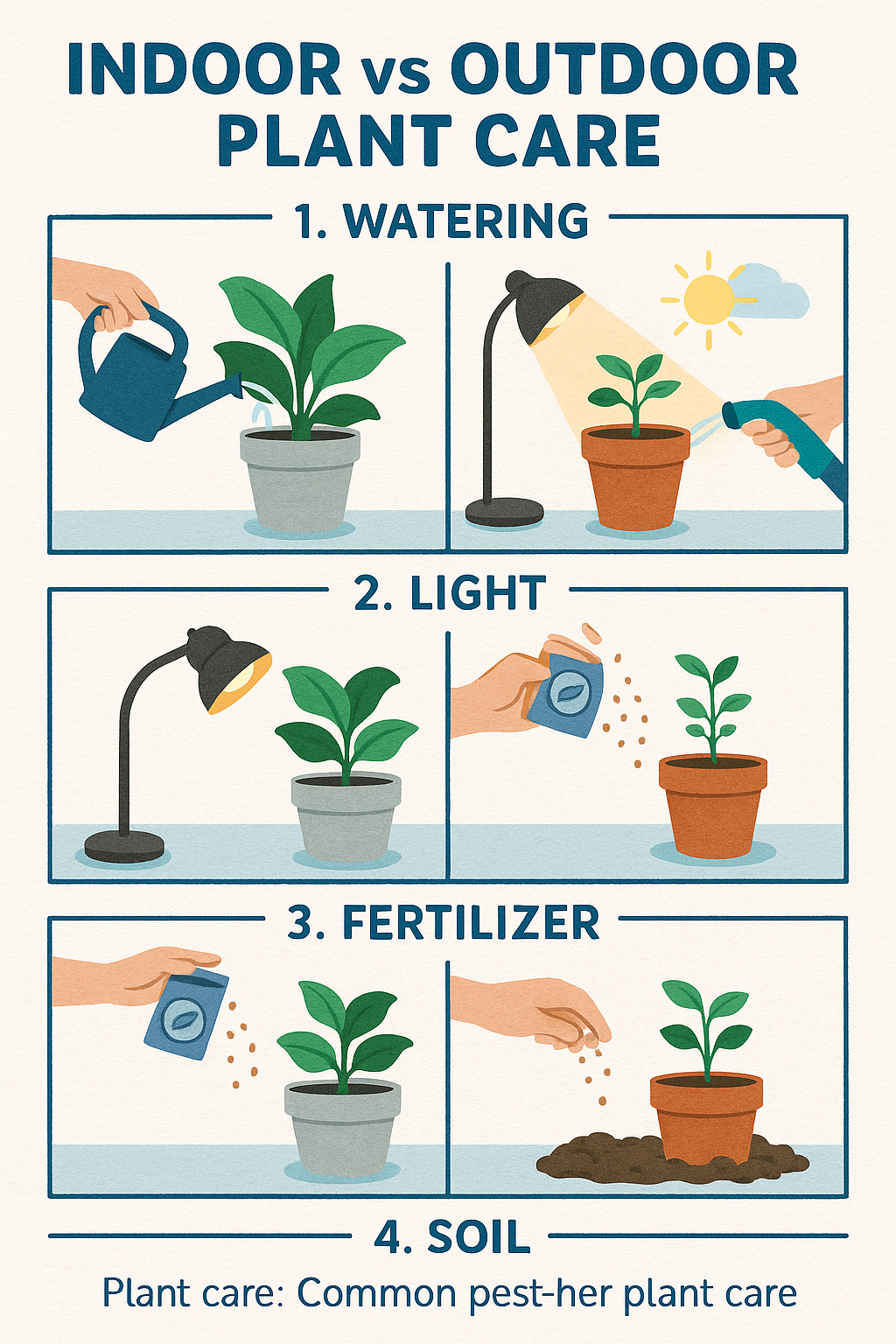Caring for plants successfully begins with understanding the key differences between indoor and outdoor plant care. Whether you’re nurturing a peace lily in your living room or tending to tomatoes on a patio, the environment plays a major role in how plants grow, thrive, or struggle. This guide breaks down the most important distinctions and offers actionable tips to help you care for plants in any setting.
Understanding the Basics of Plant Environments
What Defines Indoor vs Outdoor Plants?
Indoor plants are typically tropical species that adapt well to consistent temperature and limited light. They’re grown inside homes, offices, or greenhouses, protected from harsh weather.
Outdoor plants, on the other hand, are exposed to natural elements like sun, wind, and rain. These include both ornamental and edible plants, which often require more space and sunlight to grow effectively.
Environmental Factors That Impact Care
- Light exposure: Indoors, light is filtered through windows and often insufficient. Outdoors, plants benefit from full-spectrum sunlight.
- Temperature: Indoor environments are controlled, while outdoor temperatures fluctuate with the seasons.
- Humidity: Homes often have lower humidity, especially in winter. Outdoor plants naturally receive moisture from the air and soil.
- Air circulation: Indoors, stagnant air can lead to mold and pests. Outdoors, wind helps prevent these issues.
Key Differences in Watering
Indoor Watering Tips
- Check soil moisture before watering—don’t rely on a schedule.
- Use room-temperature water to avoid shocking the roots.
- Be mindful of drainage; standing water can cause root rot.
- Water less during colder months when growth slows down.
Outdoor Watering Guidelines
- Water early in the morning or late in the afternoon to prevent evaporation.
- Consider using a soaker hose or drip irrigation for consistency.
- Outdoor plants often need more water during summer due to heat and wind.
- Mulching helps retain soil moisture and regulate temperature.
Light Requirements: Natural vs Artificial
Maximizing Light Indoors
- Place plants near south- or east-facing windows for optimal light.
- Rotate pots weekly so all sides get equal sun exposure.
- Use grow lights for low-light rooms or during winter months.
Outdoor Light Management
- Observe the plant’s label to determine full sun, partial shade, or shade needs.
- Use garden umbrellas or plant taller species nearby for light-sensitive plants.
- Move potted plants as needed to find their optimal sun zone.
Fertilization Strategies
Feeding Indoor Plants
- Use balanced, water-soluble fertilizer every 4–6 weeks during active growth seasons.
- Reduce or pause feeding in fall and winter.
- Flush soil every few months to prevent salt buildup.
Feeding Outdoor Plants
- Use slow-release fertilizer at the beginning of the growing season.
- Supplement with compost or organic matter to enrich the soil naturally.
- Monitor for signs of overfeeding, like leaf burn or rapid but weak growth.

Pest and Disease Management
Common Indoor Plant Pests
- Fungus gnats, spider mites, and mealybugs are typical invaders.
- Regularly inspect leaves (especially undersides) and stems.
- Treat infestations with neem oil, insecticidal soap, or natural sprays.
Outdoor Threats and Prevention
- Look out for aphids, caterpillars, snails, and mildew.
- Companion planting and natural predators (like ladybugs) help control pests.
- Rotate crops and clean up dead leaves to reduce disease risks.
Potting and Soil Considerations
Indoor Soil Essentials
- Use potting mix that promotes drainage and aeration.
- Add perlite or sand for succulents and cacti.
- Repot every 1–2 years or when roots become crowded.
Outdoor Soil Tips
- Test soil pH and adjust as needed for specific plant types.
- Till and amend soil with compost before planting.
- Raised beds or containers can improve poor native soil.
Seasonal Care Differences
Adjusting Indoor Plant Care
- In winter, reduce watering and move plants away from cold drafts.
- In summer, increase misting for humidity-loving plants.
- Monitor for signs of stress such as yellowing or wilting.
Outdoor Seasonal Strategies
- Protect sensitive plants from frost with covers or by bringing them inside.
- Harvest regularly to encourage continued growth.
- In spring, prune and fertilize to prepare for the growing season.
Struggling with a plant that looks beyond saving? Check out our detailed guide on how to revive a dying houseplant for proven recovery tips.
Conclusion: Choose the Right Method for Your Space
Whether you live in a high-rise apartment or have a spacious backyard, understanding the specific needs of indoor vs outdoor plant care ensures healthier, longer-lasting greenery. Adapt your methods to your environment, and you’ll see your plants flourish.
Save this guide for your next planting weekend—or share it with a friend who’s just starting out!
FAQ: Indoor vs Outdoor Plant Care
Q1: Can I use the same soil for both indoor and outdoor plants?
Not always. Indoor plants need lightweight, well-draining mixes, while outdoor plants benefit from soil enriched with compost and natural minerals.
Q2: How do I know if my indoor plant needs more light?
Watch for signs like leggy stems, pale leaves, or slowed growth. You may need to move it closer to a window or use a grow light.
Q3: Can outdoor plants be moved indoors during winter?
Yes, but transition them gradually to avoid shock. Check for pests before bringing them inside and adjust watering accordingly.
Need basic gardening tools or high-quality potting soil? Visit The Home Depot’s garden section to find affordable supplies for both indoor and outdoor plant care.
Written by Kate Smith | Plant Care Enthusiast & Urban Gardener
